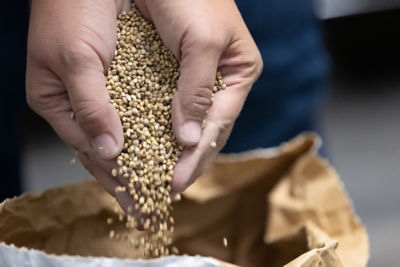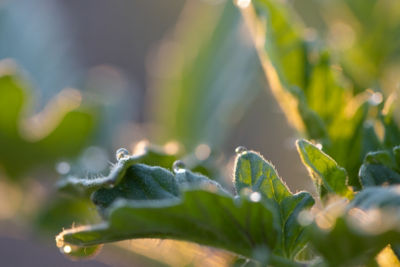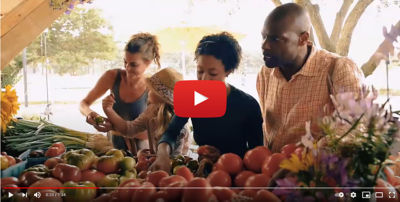Click here to download a PDF version of this spotlight.
» Pepper anthracnose causes a rot of pepper fruit, severely affecting fruit yield and marketability.
» A new pathogen species, Colletotrichum scovillei, was recently detected on peppers in Canada and the United States.
» Cultural methods and fungicide applications can be used to help manage pepper anthracnose.
Pepper anthracnose is a disease occurring primarily on pepper fruit that can result in severe yield reductions. The disease is found in pepper (Capsicum) production areas worldwide.1,2 The disease is caused by several species in the fungal genus Colletotrichum, including C. acutatum, C. gloeosporioides, C. capsicum, and C. coccodes. Anthracnose occurs on sweet and hot pepper varieties, and lesions can develop on both mature and immature fruit, depending on the pathogen species present. Isolates of C. acutatum are more often recovered from lesions on immature fruit, while isolates of C. gloeosporioides are usually recovered from lesions on mature fruit. The pepper anthracnose pathogen can infect other crop species, especially those in the Solanaceae (tomato family).2,3
A species new to North America, Colletotrichum scovillei was detected on peppers in South Carolina, U.S. in 2019 and in Ontario, Canada in 2020. C. scovillei is very aggressive and can result in more severe disease levels than is usually seen with the commonly present species.4,5 C. scovillei has also been found infecting peppers in Brazil, China, Indonesia, Japan, Malaysia, South Korea, Sri Lanka, Taiwan, and Thailand.4,6 Three strains of C. scovillei with varying virulence levels have been identified.7
SYMPTOMS
The anthracnose pathogens can affect all above-ground parts of pepper plants, including fruit, stems, and leaves, with fruit infections being the most common and damaging. Infections by Colletotrichum species can have long latent periods, the time between infection and expression of symptoms. Pepper fruit may be infected but remain symptomless for weeks, with symptoms not showing until the fruit starts to mature.1,2,3,4
Symptoms initially appear as indistinct, tan, soft, slightly sunken lesions on the fruit. Pepper fruit often become more susceptible to infection as they mature. The circular lesions (Figure 1) can enlarge to one inch (30 cm) in diameter or more, and multiple lesions can nearly cover the fruit surface (Figure 2).1,2 The lesions are often covered with salmon-pink masses of spores, and dark hairs (called setae) can form on the lesions with some species. Concentric circles of the salmon-colored spore masses or dark-colored acervuli (the spore-producing structures) can form in the lesions. On stems and leaves, the lesions usually have an irregular shape and are brown to gray with dark brown edges.
 Figure 1. Anthracnose lesions on (A) ripe and (B) green pepper fruit.
Figure 1. Anthracnose lesions on (A) ripe and (B) green pepper fruit.
 Figure 2. Multiple anthracnose lesions on pepper fruit. Gerald Holmes, Strawberry Center, Cal Poly San Luis Obispo, Bugwood.org.
Figure 2. Multiple anthracnose lesions on pepper fruit. Gerald Holmes, Strawberry Center, Cal Poly San Luis Obispo, Bugwood.org.
CYCLE AND CONDITIONS
The pepper anthracnose pathogens can survive in the field for several years as structures called microsclerotia in the soil, on infested crop debris, and on weed hosts. In addition, the pathogens can survive on and in infected pepper seeds.1,2,3 Spores produced by the pathogens also spread the disease, mostly disseminated by splashing rain or overhead irrigation. Spores can also be moved on equipment and workers’ clothing. Spores produced in the soil, on infested crop debris, or on infected plants are splashed onto the fruit, leaves, and stems of neighboring pepper plants. Warm temperatures and wet conditions favor spore germination and plant infection. Long periods of wet plant surfaces are required for infection, favored by high humidity and frequent rainfall. Infection can occur at temperatures from 50° to 86°F (10° to 30°C), and temperatures near 80°F (27°C) are optimal for anthracnose development.1,2,3
MANAGEMENT
The management of pepper anthracnose should start with the use of disease-free seeds and transplants to limit the introduction of the pathogen into the field. Rotation to non-host (non-solanaceous) crops for at least two to three years will help keep field populations of the anthracnose pathogens low. Strawberries should also not be planted as a rotation crop because they are also hosts of the anthracnose pathogens. Host weed species and solanaceous volunteer plants should be removed. Crop debris should be incorporated into the soil promptly after harvest to increase the decomposition rate. Field equipment, irrigation systems, baskets, wagons, and vehicles should be cleaned between fields to remove potentially infested soil and debris.1,2,3,8
Peppers should be planted in fields with good drainage to help reduce field moisture levels. Where possible, avoid overhead irrigation, as splashing water spreads pathogen spores and provides the free moisture on plant surfaces needed for infection. Keeping workers and equipment out of fields when the foliage is wet from rain, irrigation, or dew can help slow the spread of anthracnose. Organic and plastic mulches can act as physical barriers to help reduce the splashing of spores from the soil and crop debris up onto the pepper plants. Also, preventing wounding from insects, blowing sand, and equipment damage can help reduce the number of infection sites on plants.2,3
Disease resistance has been identified in chili types of peppers; however, no commercially available varieties are characterized as resistant to anthracnose. Some varieties of peppers appear to be less susceptible to anthracnose than others. Early maturing (shorter season) varieties may show lower disease incidence by producing fruit before warm conditions increase disease levels.2,4,8 Researchers have identified resistance in collections of peppers and related species, with a few accessions showing fairly high resistance levels. Efforts are currently underway to characterize the resistance genes in these plants and to transfer resistance into commercially acceptable varieties.4,9
Pepper fields should be scouted regularly for anthracnose symptoms, especially once fruit starts to develop. If symptoms are observed on a few plants, the fruit (of any size) on affected and nearby plants should be stripped and removed from the field as soon as possible to help limit disease spread.3,4,8
The application of fungicides can be useful to help manage anthracnose on peppers. Fungicides are usually most effective against anthracnose when applied before the disease develops in the field and when conditions are suboptimal for disease development. If scouting, begin applying fungicides as soon as symptoms are detected or when plants start to flower.1,3,8 Fungicide applications should be directed at the fruit to help ensure complete coverage. Full fruit coverage is often easier to achieve with single-row systems than with double-row planting systems. Dense canopies resulting from high nitrogen fertilization can also make it more difficult for applications to reach the fruit. High volumes of water (50 gal/ acre) are usually recommended to help facilitate adequate fungicide coverage.
Several fungicides are registered for the management of anthracnose on peppers.2,3,10 Fungicides in FRAC group 11, including azoxystrobin, famoxadone, pyraclostrobin, and trifloxystrobin, have been effective in helping to manage pepper anthracnose. When using narrow-spectrum, single-mode-of-action fungicides, it is best to mix or alternate applications with broad-spectrum fungicides, such as chlorothalonil and mancozeb, to help reduce the likelihood of developing fungicide resistance in the pathogen population.4 Always consult current product labels for application instructions and restrictions.
SOURCES
1 Alexander, S. and Pernezny, K. 2003. Anthracnose. In, Pernezny, K., Roberts, P., Murphy, J., and Goldberg, N. (Eds.), Compendium of Pepper Diseases, American Phytopathological Society, St. Paul. Ppg 9-10.
2 Roberts, P., Pernezny, K, and Kucharek, T. 2018. Anthracnose on pepper in Florida. askifas. UF IFAS Extension. Publication #PP-178. https://edis.ifas.ufl.edu/publication/PP104.
3 Stokes, C. and Meadows, I. 2021. Anthracnose of pepper. North Carolina State, Vegetable Pathology Factsheets. https://content.ces.ncsu.edu/anthracnose-of-pepper.
4 Goldenhar, K. and Tracey, A. 2022. Anthracnose management in peppers – the old and the new. ONvegetables, March 14, 2022.
https://onvegetables.com/2022/03/14/anthracnose-management-in-peppers-the-old-and-the-new/.
5 Toporek, S. and Keinath, A. 2021. First report of Colletotrichum scovillei causing anthracnose fruit rot on pepper in South Carolina, United States. Plant Disease 105(4):1222.
6 de Silva, D., Groenewald, J., Crous, P., Ades, P., Nasruddin, A., Mongkolporn, O., and Taylor, P. 2019. Identification, prevalence and pathogenicity of Colletotrichum species causing anthracnose of Capsicum annuum in Asia. IMA Fungus 10:8.
7 Hsieh, D., Chuang, S., Chen, C., Chao, Y., Lu, M., Lee, M., and Shih, M. 2022. Comparative genomics of three Colletotrichum scovillei strains and genetic analysis revealed genes involved in fungal growth and virulence on chili pepper. Front. Microbiol. 13:818291.
8 Wyenandt, A. 2016. Controlling pepper anthracnose. Plant & Pest Advisory, Rutgers Cooperative Extension.
9 Ro, N., Sebastin, R., Hur, O., Cho, G., Geum, B., Lee, Y., and Kang, B. 2021. Evaluation of anthracnose resistance in pepper (Capsicum spp.) genetic resources. Horticulturae 7:460.
10 Dittmar, P., Agehara, S., and Dufault, N. 2022. Vegetable Production Handbook of Florida 2022-2023. UF-IFSA.
Websites verified 8/18/2023
ADDITIONAL INFORMATION
For additional agronomic information, please contact your local seed representative.
Performance may vary from location to location and from year to year, as local growing, soil and weather conditions may vary. Growers should evaluate data from multiple locations and years whenever possible and should consider the impacts of these conditions on the grower’s fields. The recommendations in this article are based upon information obtained from the cited sources and should be used as a quick reference for information about vegetable production. The content of this article should not be substituted for the professional opinion of a producer, grower, agronomist, pathologist and similar professional dealing with vegetable crops.
BAYER GROUP DOES NOT WARRANT THE ACCURACY OF ANY INFORMATION OR TECHNICAL ADVICE PROVIDED HEREIN AND DISCLAIMS ALL LIABILITY FOR ANY CLAIM INVOLVING SUCH INFORMATION OR ADVICE.
6411_284778 Published 09/08/2023




